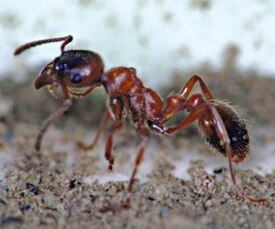Manica
 From Wikipedia (Ru) - Reading time: 5 min
From Wikipedia (Ru) - Reading time: 5 min
| Manica | ||||||||||
|---|---|---|---|---|---|---|---|---|---|---|
 Муравей Manica rubida | ||||||||||
| Научная классификация | ||||||||||
|
Домен: Царство: Подцарство: Без ранга: Без ранга: Без ранга: Без ранга: Тип: Подтип: Надкласс: Класс: Подкласс: Инфракласс: Надотряд: Hymenopterida Отряд: Подотряд: Инфраотряд: Надсемейство: Семейство: Подсемейство: Триба: Род: Manica |
||||||||||
| Международное научное название | ||||||||||
| Manica Jurine, 1807[1] | ||||||||||
| Синонимы | ||||||||||
|
||||||||||
| Виды | ||||||||||
|
См. текст |
||||||||||
| Геохронология | ||||||||||
| ||||||||||

Manica (лат.) — род муравьёв трибы Myrmicini из подсемейства Myrmicinae (Formicidae). Голарктика. Известно 7 видов, включая два ископаемых.
Распространение
[править | править код]Палеарктика. Неарктика. В Европе 1 вид.
Описание
[править | править код]Мелкие муравьи рыжевато-бурого цвета (длина около 5—6 мм), похожие на крупных представителей рода Myrmica. У вида Manica rubida обнаружены матки-микрогины, функция которых остается неясной[2].
Классификация
[править | править код]7 видов. Относятся к трибе Myrmicini.
Синонимы
[править | править код]- Neomyrma Forel, 1914 (описан как подрод в роде Aphaenogaster)
- Oreomyrma Wheeler, 1914
Современные виды
[править | править код]- Manica bradleyi (Wheeler, 1909) — США
- = Aphaenogaster calderoni Forel, 1914
- = Manica parasitica (Creighton, 1934)[3]
- Manica hunteri (Wheeler, 1914) — Канада, США
- = Myrmica aldrichi Wheeler, 1914
- Manica invidia Bolton, 1995 (= Myrmica mutica Emery) — Канада, США
- = Myrmica mutica Emery, 1895
- Manica rubida (Latreille, 1802) typus (=Formica rubida) — Европа
- = Myrmica leonina Losana, 1834
- = Myrmica montana Labram & Imhoff, 1838
- Manica yessensis Azuma, 1955 — Япония
Исключённые виды
[править | править код]- в род Myrmica перенесён Manica shanyii He et al., 2024 — Китай[4][5]
Палеонтология
[править | править код]- †Manica andrannae Zharkov et Dubovikoff, 2023 — балтийский янтарь, эоцен
- †Manica iviei LaPolla, 2023 — США, олигоцен (Canyon Ferry Reservoir, Монтана)[6]
Примечания
[править | править код]- ↑ Jurine, L. Nouvelle méthode de classer les Hyménoptères et les Diptères. — Paschoud, Geneva, 1807. — 319 с.
- ↑ Alain Lenoir, Severine Devers, Philippe Marchan, Christophe Bressac, and Riitta Savolainen. Microgynous queens in the Paleartic ant, Manica rubida: Dispersal morphs or social parasites? (англ.) // Journal of Insect Science : журнал. — 2010. — Vol. 10, no. 17. Архивировано из оригинала 8 января 2014 года.
- ↑ Prebus, M., Georgiev, B.B., van de Kamp, T., Hamann, E., Baker, I., Rabeling, C. 2023. The rediscovery of the putative ant social parasite Manica parasitica syn. nov. (Hymenoptera: Formicidae) reveals an unexpected endoparasite syndrome. Biology Letters, 19, 20230399 (doi:10.1098/rsbl.2023.0399).
- ↑ He Y, Chen Z, Du C (2024) Review of the ant genus Manica (Hymenoptera, Formicidae), with a new record of the genus in China and description of a new species. Journal of Hymenoptera Research 97: 379—398. https://doi.org/10.3897/jhr.97.111418
- ↑ Zharkov, D. M.; Dubovikoff, D. A.; Fu, Y.; Abakumov, E. V. 2024. Manica shanyii (Hymenoptera: Formicidae: Myrmicinae) is not Manica. Ecologica Montenegrina 78:11—16.
- ↑ LaPolla, J.S. 2023. Fossil ants (Hymenoptera: Formicidae) of the early Oligocene Canyon Ferry Reservoir deposit. Palaeoentomology 6(4), 385—397 (doi: https://doi.org/10.11646%2Fpalaeoentomology.6.4.10).
Литература
[править | править код]- Cammaerts, M. C. and R. Cammaerts. Food-collection behaviour of the ant Manica rubida (англ.) // Biol. Behav. : журнал. — 1985. — Vol. 10. — P. 291–308.
- Cole A. C., Jr. Studies of New Mexico ants. IV. The genera Myrmica, Manica, Aphaenogaster, and Novomessor (Hymenoptera: Formicidae) (англ.) // J. Tenn. Acad. Sci. : журнал. — 1953. — Vol. 28. — P. 242–244.
- Wheeler G. C., J. Wheeler. The natural history of Manica (Hymenoptera: Formicidae) (англ.) // J. Kansas Entomol. Soc. : журнал. — 1970. — Vol. 43. — P. 129–162.
- Zharkov D., Dubovikoff D., Abakumov E. The first fossil record of the genus Manica Jurine, 1807 from Late Eocene Baltic amber and discussion of the early evolution of Myrmicini (Hymenoptera: Formicidae: Myrmicinae) (англ.) // Insects. — 2022. — Vol. 14, no. 21.
Это заготовка статьи по мирмекологии. Помогите Википедии, дополнив её. |
Licensed under CC BY-SA 3.0 | Source: https://ru.wikipedia.org/wiki/Manica62 views | Status: cached on August 06 2025 23:03:04↧ Download this article as ZWI file
 KSF
KSF